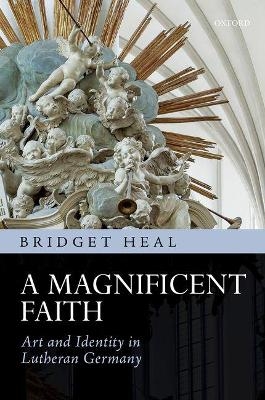
A Magnificent Faith
Art and Identity in Lutheran Germany
Seiten
2017
Oxford University Press (Verlag)
978-0-19-873757-5 (ISBN)
Oxford University Press (Verlag)
978-0-19-873757-5 (ISBN)
The first comprehensive history of the Reformation origins and flourishing of Lutheran baroque; while the Protestant reform movements are generally associated with iconoclasm, this book studies art, religion, and politics to show that in Lutheran Germany a rich visual culture developed, despite theologians' ambivalent attitude towards images.
A Magnificent Faith explains how and why Lutheranism - a confession that derived its significance from the promulgation of God's Word - became a visually magnificent faith, a faith whose adherents sought to captivate Christians' hearts and minds through seeing as well as through hearing. Although Protestantism is no longer understood as an exclusively word-based religion, the paradigm of evangelical ambivalence towards images retains its power. This is the first study to offer an account of the Reformation origins and subsequent flourishing of the Lutheran baroque, of the rich visual culture that developed in parts of the Holy Roman Empire during the later seventeenth and early eighteenth centuries. The volume opens with a discussion of the legacy of the Wittenberg Reformation. Three sections then focus on the confessional, devotional, and magnificent image, exploring turning points in Lutherans' attitudes towards religious art. Drawing on a wide variety of archival, printed, and visual sources from two of the Empire's most important Protestant territories - Saxony, the heartland of the Reformation, and Brandenburg - A Magnificent Faith shows the extent to which Lutheran culture was shaped by territorial divisions. It traces the development of a theologically-grounded aesthetic, and argues that images became prominent vehicles for the articulation of Lutheran identity not only amongst theologians but also amongst laymen and women. By examining the role of images in the Lutheran tradition as it developed over the course of two centuries, A Magnificent Faith offers a new understanding of the relationship between Protestantism and the visual arts.
A Magnificent Faith explains how and why Lutheranism - a confession that derived its significance from the promulgation of God's Word - became a visually magnificent faith, a faith whose adherents sought to captivate Christians' hearts and minds through seeing as well as through hearing. Although Protestantism is no longer understood as an exclusively word-based religion, the paradigm of evangelical ambivalence towards images retains its power. This is the first study to offer an account of the Reformation origins and subsequent flourishing of the Lutheran baroque, of the rich visual culture that developed in parts of the Holy Roman Empire during the later seventeenth and early eighteenth centuries. The volume opens with a discussion of the legacy of the Wittenberg Reformation. Three sections then focus on the confessional, devotional, and magnificent image, exploring turning points in Lutherans' attitudes towards religious art. Drawing on a wide variety of archival, printed, and visual sources from two of the Empire's most important Protestant territories - Saxony, the heartland of the Reformation, and Brandenburg - A Magnificent Faith shows the extent to which Lutheran culture was shaped by territorial divisions. It traces the development of a theologically-grounded aesthetic, and argues that images became prominent vehicles for the articulation of Lutheran identity not only amongst theologians but also amongst laymen and women. By examining the role of images in the Lutheran tradition as it developed over the course of two centuries, A Magnificent Faith offers a new understanding of the relationship between Protestantism and the visual arts.
Bridget Heal studied at the universities of Cambridge and London. Since 2002 she has taught at the University of St Andrews, where she is currently director of the Reformation Studies Institute. In 2010-2011 she held a visiting fellowship from the Alexander von Humboldt Foundation at the Freie Universität in Berlin. Her research focuses on the religious, social, and cultural history of early modern Germany. Her publications include The Cult of the Virgin Mary in Early Modern Germany: Protestant and Catholic Piety, 1500-1648 (2007).
PART I: THE CONFESSIONAL IMAGE; PART II: THE DEVOTIONAL IMAGE; PART III: THE MAGNIFICENT IMAGE
| Erscheinungsdatum | 21.08.2017 |
|---|---|
| Zusatzinfo | black and white images |
| Verlagsort | Oxford |
| Sprache | englisch |
| Maße | 171 x 242 mm |
| Gewicht | 776 g |
| Themenwelt | Kunst / Musik / Theater ► Kunstgeschichte / Kunststile |
| Geschichte ► Allgemeine Geschichte ► Neuzeit (bis 1918) | |
| Geisteswissenschaften ► Geschichte ► Regional- / Ländergeschichte | |
| Geschichte ► Teilgebiete der Geschichte ► Religionsgeschichte | |
| Geisteswissenschaften ► Religion / Theologie ► Christentum | |
| ISBN-10 | 0-19-873757-2 / 0198737572 |
| ISBN-13 | 978-0-19-873757-5 / 9780198737575 |
| Zustand | Neuware |
| Haben Sie eine Frage zum Produkt? |
Mehr entdecken
aus dem Bereich
aus dem Bereich
Europa 1848/49 und der Kampf für eine neue Welt
Buch | Hardcover (2023)
DVA (Verlag)
48,00 €
Giordano Bruno - ein ketzerisches Leben
Buch | Hardcover (2024)
C.H.Beck (Verlag)
29,90 €


